Introduction
Do you remember the first time you saw a Venus flytrap? That tiny plant, seemingly still, with its fascinating traps, embodying the perfect predator right on your kitchen table. As children, many of us were captivated by this miniature marvel of nature.
As cultivators, it’s crucial to understand that the Venus flytrap (Dionaea muscipula) is carnivorous from the moment it emerges as a seedling, sporting its first miniature trap. Even these incredibly small, newly sprouted plants are capable of capturing prey and, importantly, benefit immensely from being fed, leading to significantly accelerated growth.
In this guide, we’ll delve into a proven technique for nurturing these seedlings to their full potential, using freeze-dried bloodworms. This method has been personally tested and refined, successfully taking Venus flytraps from seed to adult, flowering size in as little as eight months!
Further on, we’ll briefly touch upon feeding other types of carnivorous plants, expanding your knowledge beyond just Venus flytraps.
Let’s embark on this journey to understand how strategic feeding can unlock rapid growth for your Venus flytraps, transforming them from delicate seedlings to robust adult plants in a remarkably short time.
Accelerating Venus Flytrap Growth: Seed to Adult in Months
A handful of Venus flytrap seeds, ready for sowing. High-quality seeds are the first step towards rapid growth.
The journey to rapidly growing Venus flytraps begins with high-quality seed germination. Just like giving a child a good start in life, strong initial growth sets the stage for continued success. A robust start allows young Venus flytraps to maintain a rapid growth rate, establishing a vigorous seedling right from the beginning.
The initial step is sowing your Venus flytrap seeds for germination. Long-fiber sphagnum moss (dead) or living sphagnum moss serve as excellent germination mediums. Sprinkle the seeds on the surface of the moss. Light is crucial for seedlings as soon as they sprout, so avoid burying the seeds.
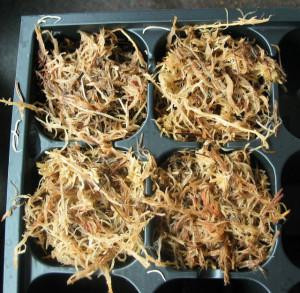 Flytrap Seed Sowing
Flytrap Seed Sowing
Venus flytrap seeds being sown on sphagnum moss. Surface sowing and ample light are key for successful germination.
For optimal germination, aim for high relative humidity and relatively warm temperatures. A temperature range of 30°C (86°F) during the day and 25°C (77°F) at night provides what carnivorous plant enthusiasts often refer to as “lowland conditions,” ideal for rapid sprouting.
Germination typically occurs within 10 to 20 days, but it can take longer if conditions aren’t perfect. To maintain the necessary high humidity, use a plastic dome or a terrarium designed for humidity control. Maintaining 90% to 100% relative humidity is ideal for the quickest germination.
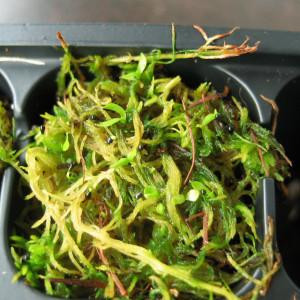 Venus Flytrap Seed Germination
Venus Flytrap Seed Germination
Venus flytrap seed germination. High humidity and warmth promote quick and healthy sprouting.
After germination, continue to maintain high relative humidity. While some growers reduce humidity to prevent algae and fungal issues, keeping humidity high promotes faster seedling growth, mimicking their native environment.
Within the first two weeks post-germination, tiny, square-shaped traps will appear on your Venus flytrap seedlings. These miniature traps are fully functional and ready to capture prey. It’s at this critical stage, right after the first trap opens, that feeding becomes essential.
The Power of Nutrition: Fueling Rapid Venus Flytrap Growth
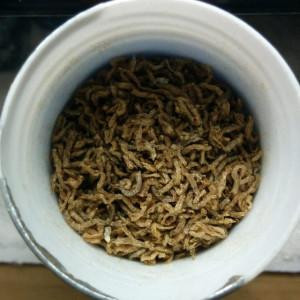 Dehydrated Blood Worms
Dehydrated Blood Worms
Freeze-dried bloodworms, a protein-rich food source ideal for boosting Venus flytrap growth.
Let’s understand why feeding is so beneficial. Venus flytraps, related to the King Sundew (Drosera regia), evolved their sophisticated traps to maximize nutrient uptake from prey. Unlike sticky sundews that often catch flying insects with lower nutritional value, Venus flytraps with their closing traps are optimized for capturing crawling insects.
Crawling insects like worms, spiders, and larger ants offer a richer source of nitrogen, the key nutrient carnivorous plants seek to supplement from their prey due to nutrient-poor soil conditions in their natural habitats. The Venus flytrap’s closed trap mechanism enhances the efficiency of nutrient assimilation compared to the open, sticky leaves of sundews.
This is where freeze-dried bloodworms become invaluable. They are exceptionally high in crude protein and nitrogen, providing a potent nutritional boost that accelerates growth.
 Pot of young, hungry Venus Flytraps
Pot of young, hungry Venus Flytraps
A pot of young, hungry Venus flytrap seedlings eagerly awaiting feeding to fuel their rapid development.
While large commercial nurseries may not hand-feed every seedling, this personal method is incredibly effective for home growers. Nurseries might opt for foliar fertilization or dilute fertilizer in the soil, but direct feeding offers targeted nutrition right where it’s needed – in the traps. Tissue culture propagation is another method for rapid, sterile growth in nurseries. However, for individual growers, targeted feeding is a highly accessible and effective technique.
Step-by-Step Guide: Feeding Your Venus Flytrap Bloodworms
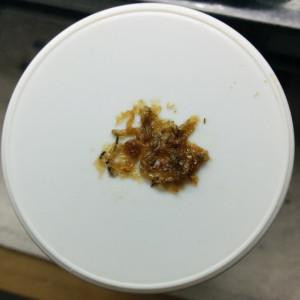 Rehydrating Freeze-Dried Blood Worms
Rehydrating Freeze-Dried Blood Worms
Rehydrating freeze-dried bloodworms. Moistening the worms makes them easier for the Venus flytrap to digest and handle.
For Venus flytraps and sundews, rehydrating freeze-dried bloodworms is recommended. Soak the bloodworms in a little water, then drain any excess. Roll the moistened worms into small “meatballs,” no larger than one-third the size of the Venus flytrap’s trap. Oversized food pieces can cause trap rot.
Feeding Procedure:
- Prepare the bloodworm meatball: Take a small piece of rehydrated bloodworm and place it on the tip of a toothpick.
- Introduce the food: Gently insert the bloodworm meatball into an open Venus flytrap trap.
- Trigger the trap: Gently wiggle the toothpick inside the trap to stimulate the trigger hairs. The trap should snap shut. Seedling traps may close slowly, so be patient.
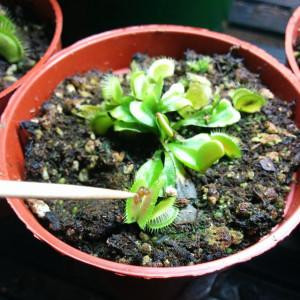 Feed a Venus flytrap
Feed a Venus flytrap
Inserting a bloodworm meatball into the open trap of a young Venus flytrap using a toothpick for precision.
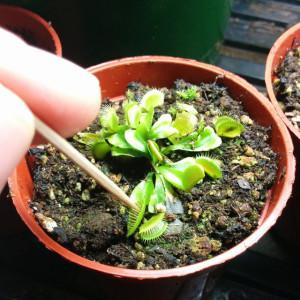 Feeding a young Venus Fly Trap
Feeding a young Venus Fly Trap
Ensuring the Venus flytrap trap is triggered to close after placing the bloodworm inside. A closed trap initiates the digestion process.
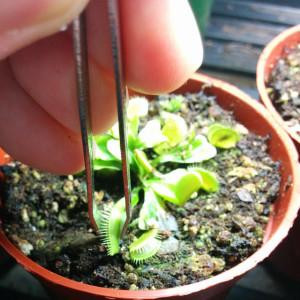 Feeding a young Venus Fly Trap
Feeding a young Venus Fly Trap
Massaging the sides of the Venus flytrap trap to mimic struggling prey and encourage complete sealing and digestion.
When a Venus flytrap catches live prey, the insect’s struggles inside the trap continue to stimulate the trigger hairs, signaling the trap to seal and begin digestion. This prevents the plant from wasting energy digesting non-nutritious items. Since bloodworms are not live, we need to manually encourage this sealing process.
- Seal the trap: Using two toothpicks, forceps, or even your fingertips, gently press on both sides of the closed trap. This mimics the movement of live prey and encourages the trap to seal. If the trap isn’t sealed within 30 minutes, repeat the gentle pressing.
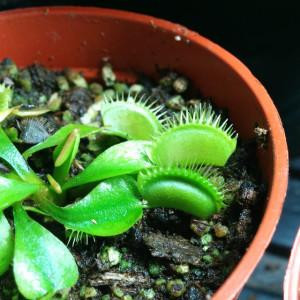 Sealed and Digesting Young Venus Flytrap
Sealed and Digesting Young Venus Flytrap
A sealed Venus flytrap trap, indicating that the digestion process has successfully commenced. The trap will remain closed for several days.
A sealed trap signifies that digestion has begun! The trap will remain closed for about 5 days in warm conditions. A healthy trap can digest 2 to 4 meals before becoming inactive. Even inactive traps, as long as they remain green, still contribute to the plant through photosynthesis, so avoid removing them prematurely.
For optimal growth, aim to feed one or two traps per Venus flytrap, once a week. This regular feeding significantly boosts their growth rate.
 Quickly Growing Young Venus Flytraps
Quickly Growing Young Venus Flytraps
Young Venus flytraps exhibiting rapid growth thanks to consistent feeding and ideal growing conditions.
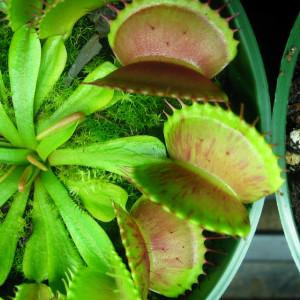 Nearly Adult-sized Venus Flytraps
Nearly Adult-sized Venus Flytraps
Venus flytraps approaching adult size, demonstrating the effectiveness of regular feeding in accelerating their growth trajectory.
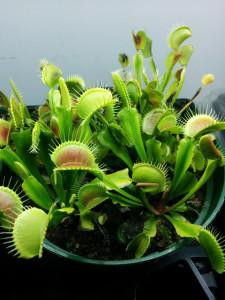 Nearly Adult-sized Venus Flytraps
Nearly Adult-sized Venus Flytraps
Close-up view of nearly adult-sized Venus flytraps, showcasing robust health and vigorous growth achieved through strategic feeding.
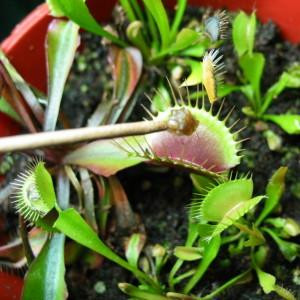 Nearly Adult-sized Venus Flyfraps
Nearly Adult-sized Venus Flyfraps
Even larger, nearly adult Venus flytraps still benefit from regular bloodworm feeding to maintain their accelerated growth and vitality.
Ideal Growing Conditions for Venus Flytraps
To maximize the benefits of feeding, provide optimal growing conditions:
- Humidity: Maintain 80% relative humidity consistently.
- Temperature: 24°C (75°F) during the day, with a nighttime low of 18°C (65°F). Increase daytime temperature to 28°C (82°F) for 48 hours post-feeding to aid digestion.
- Light: High output T5 fluorescent tubes with full spectrum, 16-hour photoperiod (16 hours on, 8 hours dark). Supplement with blue spectrum 2700K vertical tubes on the sides.
- Airflow: Gentle airflow around the plants.
- Soil: 50% peat moss, 25% perlite, 25% coconut husk chunks.
- Watering: Water twice weekly from the top with distilled water.
This feeding method with rehydrated bloodworms is beneficial at all growth stages, not just for seedlings.
Feeding Other Carnivorous Plant Genera
Freeze-dried bloodworms can benefit almost all carnivorous plant genera. For pitcher plants like Heliamphora, Cephalotus, Nepenthes, and some Sarracenia, dusting dry freeze-dried bloodworms directly into the pitchers is effective. Alternatively, use rehydrated worms and deposit them into the pitchers with a toothpick, similar to feeding Venus flytraps.
 Feeding Heliamphora Dehydrated Blood Worms
Feeding Heliamphora Dehydrated Blood Worms
Feeding Heliamphora pitcher plants with dehydrated bloodworms. Pitcher plants readily accept bloodworms as a nutritional supplement.
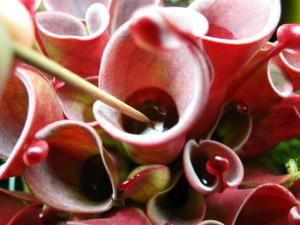 Feeding Heliamphora Dehydrated Blood Worms
Feeding Heliamphora Dehydrated Blood Worms
Close-up of bloodworms being dusted into a Heliamphora pitcher. Dusting is an easy method for feeding pitcher plants.
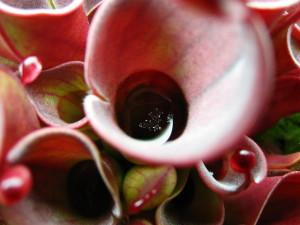 Feeding Heliamphora Dehydrated Blood Worms
Feeding Heliamphora Dehydrated Blood Worms
Another view of Heliamphora pitchers being fed. Regular feeding supports healthy pitcher development and plant growth.
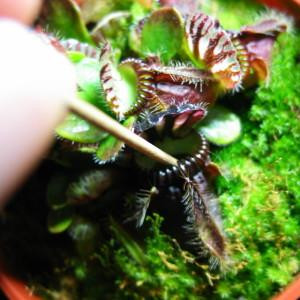 Feeding Cephalotus Dehydrated Blood Worms
Feeding Cephalotus Dehydrated Blood Worms
Feeding Cephalotus follicularis with dehydrated bloodworms. Even small pitchers like those of Cephalotus can benefit from supplemental feeding.
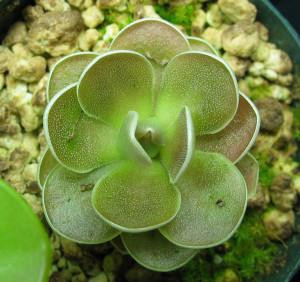 Feeding Pinguicula Dehydrated Blood Worms
Feeding Pinguicula Dehydrated Blood Worms
Feeding Pinguicula (butterworts) using the dusting method. Fine dusting ensures the sticky leaves can effectively capture the food.
For Utricularia and Genlisea, feeding is challenging. Sarracenia minor can also be difficult to feed. For some genera, grinding freeze-dried bloodworms into a finer powder may improve digestibility.
Conclusion: Unlock Rapid Growth with Strategic Feeding
Freeze-dried bloodworms are readily available in pet stores and drugstores as fish food. While they are a fantastic tool for accelerated growth, be aware that some individuals are allergic to them. Exercise caution, using toothpicks to avoid direct contact.
A single container of freeze-dried bloodworms is an inexpensive, efficient, and highly rewarding way to dramatically accelerate the growth of your Venus flytraps and other carnivorous plants. Embrace this simple technique and witness your plants thrive!
– Francois Boulianne (Maiden)
External Resources
- Barry Rice on Feeding Venus flytraps: http://www.sarracenia.com/faq/faq2460.html